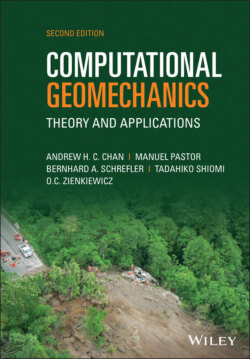Читать книгу Computational Geomechanics - Manuel Pastor - Страница 32
2.5.4 Constitutive Equations
ОглавлениеConstitutive models are selected here which are based on quantities currently measurable in laboratory or field experiments and which have been extensively validated. Most of them have been obtained from entropy inequality; see Hassanizadeh and Gray (1980, 1990).
It can be shown that the stress tensor in the fluid is
(2.67)
where pπ is the fluid pressure, and in the solid phase is
(2.68)
with ps = pw Sw + pa Sa in the case of thermodynamic equilibrium or for incompressible solid grains (2.50).
The sum of (2.67), written for air and water and of (2.68), gives the total stress σ, acting on a unit area of the volume fraction mixture
(2.69)
This is the form of the effective stress (2.51), also called generalized Bishop stress (Nuth and Laloui 2008), employed in the following, as already explained.
Moist air in the pore system is assumed to be a perfect mixture of two ideal gases, dry air and water vapour, with π = ga and π = gw, respectively. The equation of a perfect gas is hence valid
(2.70)
where Mπ is the molar mass of constituent π, R the universal gas constant, and θ the common absolute temperature. Further, Dalton’s law applies and yields the molar mass of moisture
(2.71)
Water is usually present in the pores as a condensed liquid, separated from its vapor by a concave meniscus because of surface tension. The capillary pressure is defined as pc = pg − pw, see Equation (2.43).
The momentum exchange term of the linear momentum balance equation for fluids has the form
(2.72)
where vπs is the velocity of the π phase relative to the solid.
It is assumed that Rπ is invertible, its inverse being and kπ is defined by the following relation:
(2.73)
where μπ is the dynamic viscosity with dimensions [mass] [length]−1 [time]−1, K the intrinsic permeability [length]2 and T the temperature above some datum. The permeability of (2.73) is the dynamic permeability [length]3 [mass]−1 [time]; to obtain the soil mechanics permeability k′ [length]/[time], Equation (2.73) has to be multiplied by the specific weight of water γw of dimensions [mass] [length]−2 [time]−2. In the case of more than one fluid flowing, the intrinsic permeability is modified as
(2.74)
where Krπ is the relative permeability, a function of the degree of saturation. For the water density, the following holds:
(2.75)
where Kw is the bulk modulus of water.
